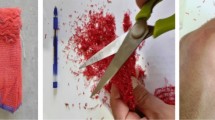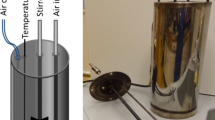Abstract
The bitumens, having different compositions, and recycled polyethylene, consisting of low- and high-melting point crystallites, were used for the preparation of bitumen/polymer blends. The structure of bitumen/polymer blends is studied using methods of calorimetry, optical microscopy and oscillatory shear test. The different thermal and viscoelastic behaviors are found at low and high contents of the recycled polyethylene in bitumen/polymer blends. A study of the concentration dependences of thermal characteristics shows that an abrupt increase in the melting enthalpy of bitumen/polymer blends with a monotonous increase in the concentration of polyethylene is due to the formation of a co-continuous structure in the blend. It is revealed that the thermal behavior of bitumen/polymer blends can be used for evaluation of the degree of compatibility of polycrystalline recycled polyethylene and bitumens. The assumption is made that the absence of the low-temperature effects on the heat flow curves of bitumen/polymer blends can testify the good compatibility of bitumen and polycrystalline recycled polyethylene.





Similar content being viewed by others
References
Lesueur D. The colloidal structure of bitumen: consequence on the rheology and on the mechanism of bitumen modification. Adv Colloid Interface Sci. 2009. https://doi.org/10.1016/j.cis.2008.08.011.
Polacco G, Stastna J, Biondi D, Zanzotto L. Relation between polymer architecture and nonlinear viscoelastic behavior of modified asphalts. Curr Opin Colloid Interface Sci. 2006. https://doi.org/10.1016/j.cocis.2006.09.001.
Garcia-Morales M, Partal P, Navarro FJ, Martinez-Boza FJ, Gallegos C. Linear viscoelasticity of recycled EVA-modified bitumens. Energy Fuels. 2004. https://doi.org/10.1021/ef034032u.
Garcia-Morales M, Partal P, Navarro FJ, Martinez-Boza FJ, Gallegos C, González N, González O, Muñoz ME. Viscous properties and microstructure of recycled EVA modified bitumen. Fuel. 2004. https://doi.org/10.1016/S0016-2361(03)00217-5.
Fuentes-Audern C, Sandoval JA, Jerez A, Navarro FJ, Martinez-Boza FJ, Partal P, Gallegos C. Evaluation of thermal and mechanical properties of recycled polyethylene modified bitumen. Polym Test. 2008. https://doi.org/10.1016/j.polymertesting.2008.09.006.
La Mantia F. Handbook of Plastics Recycling. Shropshire: Rapra Technology Limited; 2002. https://doi.org/10.1002/pi.1323.
Edwards Y, Redelius P. Rheological effect of waxes in bitumen. Energy Fuels. 2003. https://doi.org/10.1021/ef020202b.
Frolov IN, Yusupova TN, Ziganshin MA, Okhotnikova ES, Firsin AA. Formation of phase composition of petroleum bitumen according to data of temperature modulated differential scanning calorimetry. J Therm Anal Calorim. 2018. https://doi.org/10.1007/s10973-017-6779-1.
Cser F, Hopewell JL, Shanks RA. Reversible melting of thermally fractionated polyethylene. J Therm Anal Calorim. 1998. https://doi.org/10.1023/A:1010123416624.
Chau J, Garlicka I, Wolf C, Teh J. Modulated DSC as a tool for polyethylene structure characterization. J Therm Anal Calorim. 2007. https://doi.org/10.1007/s10973-007-8527-4.
Wang Z, Wei R, Ning X, et al. Thermal degradation properties of LDPE insulation for new and aged fine wires. J Therm Anal Calorim. 2018. https://doi.org/10.1007/s10973-018-7957-5.
Memon GM, Chollar BH. Glass transition measurements of asphalts by DSC. J Therm Anal Calorim. 1997. https://doi.org/10.1007/BF01996742.
Zhang F, Hu Ch. The research for thermal behaviour, creep properties and morphology of SBS-modified asphalt. J Therm Anal Calorim. 2015. https://doi.org/10.1007/s10973-015-4595-z.
Ragab AA, Mohammedy MM, El-Shafie M. Using waste flexible polyvinyl chloride treated with DOP/calcium hydroxide for enriching the performance of oxidizing bitumen. J Therm Anal Calorim. 2018. https://doi.org/10.1007/s10973-018-7754-1.
Xia T, Zhou L, Xu J, Qin Y, Chen W, Dai J. Rheology and thermal stability of polymer modified bitumen with coexistence of amorphous phase and crystalline phase. Constr Build Mater. 2018. https://doi.org/10.1016/j.conbuildmat.2018.05.073.
Perez-Lepe A, Martinez-Boza FJ, Gallegos C. Influence of polymer concentration on the microstructure and rheological properties of high—density polyethylene (HDPE)—modified bitumen. Energy Fuels. 2005. https://doi.org/10.1021/ef0497513.
Zhang F, Hu Ch, Zhuang W. The research for low-temperature rheological properties and structural characteristics of high-viscosity modified asphalt. J Therm Anal Calorim. 2018. https://doi.org/10.1007/s10973-017-6569-9.
Wu SP, Zhu GJ, Liu G, Pang L. Laboratory research on thermal behavior and characterization of the ultraviolet aged asphalt binder. J Therm Anal Calorim. 2009. https://doi.org/10.1007/s10973-008-9252-3.
Laukkanen O, Soenen H, Winter HH, Seppälä J. Low-temperature rheological and morphological characterization of SBS modified bitumen. Constr Build Mater. 2018. https://doi.org/10.1016/j.conbuildmat.2018.05.160.
Fawcett AH, McNally T, McNally G. An attempt at engineering the bulk properties of blends of bitumen with polymers. Adv Polym Tech. 2004. https://doi.org/10.1002/adv.10032.
Perez-Lepe A, Martinez-Boza FJ, Attane P, Gallegos C. Destabilization mechanism of polyethylene—modified bitumen. J Appl Polym Sci. 2008. https://doi.org/10.1002/app.23091.
Funding
The study was carried out at the expense of a Grant from the Russian Science Foundation (Project No. 17–73-10011).
Author information
Authors and Affiliations
Corresponding author
Additional information
Publisher's Note
Springer Nature remains neutral with regard to jurisdictional claims in published maps and institutional affiliations.
Rights and permissions
About this article
Cite this article
Okhotnikova, E.S., Ganeeva, Y.M., Frolov, I.N. et al. Assessing the structure of recycled polyethylene-modified bitumen using the calorimetry method. J Therm Anal Calorim 138, 1243–1249 (2019). https://doi.org/10.1007/s10973-019-08172-1
Received:
Accepted:
Published:
Issue Date:
DOI: https://doi.org/10.1007/s10973-019-08172-1




